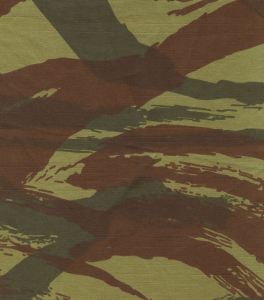
TAP-47
The Lizard pattern (TAP47 pattern or Leopard pattern for the French) is a kind of military camouflage pattern used by the French Army on uniforms from 1947 to the late 1980s.
A Lizard pattern has two overlapping prints, generally green and brown, printed with gaps so that a third dyed color, such as a lighter green or khaki, makes up a large part of the pattern. In this, it is printed like earlier British patterns used on that country's Paratroopers Denison smocks. Lizard patterns have narrower printed areas than the British patterns, and have a strong horizontal orientation, cutting across the vertical form of a man's body. Other patterns descend in turn from Lizard patterns, either by direct imitation such as Cuba's Lizard pattern, or innovation, such as the tigerstripe patterns produced during the Vietnam War. Tigerstripe patterns (French experimental development during the Indochina war which was based on the TAP47 pattern and which became the South Vietnamese Marines pattern) differed from Lizard patterns in that their printed areas are interlocked rather than overlapped, and they use smaller areas of dyed background color.
The term "lizard" pattern has been applied over time to mean the horizonally-striped French patterns of the 1950s that were direct descendants of the original British brushstroke pattern of the Second World War. The French generally referred to the pattern as camouflee de leópard (leopard camouflage); the term "lizard" actually refers to a local nickname for French paratroops during the Algerian War. As paratroops were synonymous with the striped camouflage design, the nickname stuck and over time came to refer to the camouflage pattern itself. This term has interestingly become the most widely accepted name among historians and collectors for the original French design, and the innumerable derivative patterns that were spawned thereafter.